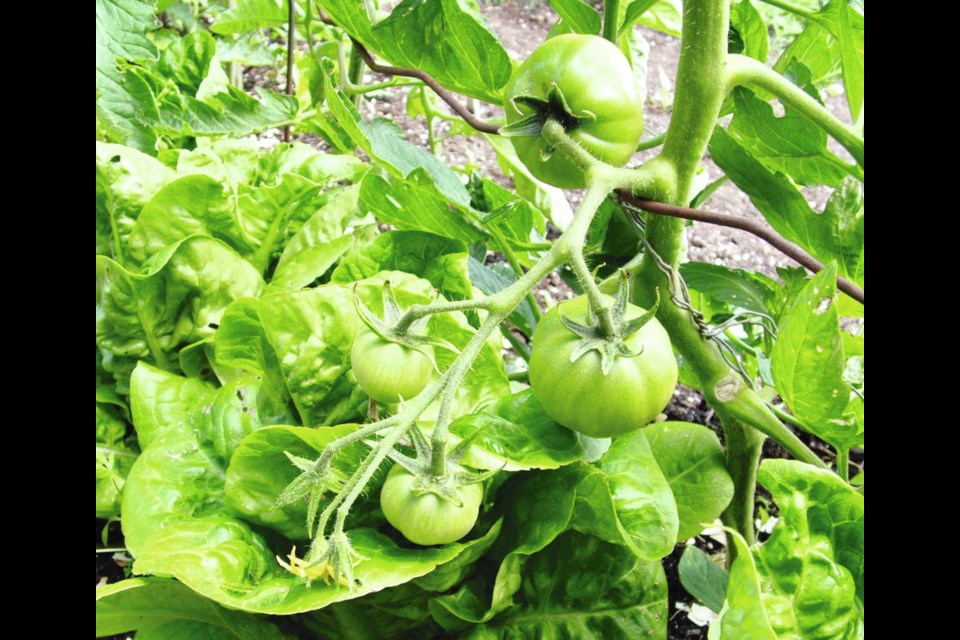Dear Helen: A summer visitor to my garden commented on cucumber and tomato vines growing on the same support. She said the two are harmful to each other’s growth. Is she right?
G.P.
I see nothing in the companion planting books and lists I have to suggest that these two plants do not do well together. Several list the two as being suitable companions.
Like many food gardeners, I need to make the best possible use of all the good growing spaces available to me. That means growing plants as close together as is reasonably possible, in fertile, humus-plumped soil. To that end I also grew cucumber vines together with staked and pruned tomatoes on a length of sturdy wire fencing. Both the tomatoes and cucumbers grew and produced well.
Dear Helen: Is it true that cabbages grown next to tomatoes will stunt the tomato growth?
B.A.
I have heard reports of tomatoes being stunted when cabbages are grown very close by, as in snuggled up against tomato stem bases, especially in confined areas like greenhouse and raised, boxed outdoor beds. This could simply be that cabbages are extra greedy feeders and out-compete the tomatoes for nutrients
Both books I have on companion planting say that tomatoes are good companion plants to cabbages and other members of the cabbage family, because the tomato foliage repels cabbage butterflies.
Personally, I never grow heavy feeders like cabbage family vegetables next to tomatoes, but I do use the tomato “suckers” removed from my staked tomatoes to repel the cabbage butterfly — simply by laying the suckers on the cabbage, broccoli, and cauliflower plants. A veteran gardener from Holland gave me that useful tip.
The only plants I snuggle up close to the bases of my staked tomatoes are very light feeders. Lettuce transplants are my usual choices. In summer they do splendidly close to and on the shaded side of the tomatoes.
Dear Helen: More of my apples than usual were damaged this year by some sort of pest that marred the flesh of the fruit. How can I identify the pest so that I can take measures against it next year?
F.L.
The two main pests that target apples are coddling moth and apple maggot. You can tell which one you are dealing with by the nature of the damage.
Coddling moths emerge soon after apple blossom time to lay eggs on and near developing fruit. The eggs hatch into larvae that bore into the core of the small apples to feed in the core for around a month before crawling out to pupate and produce a second generation of egg-laying adults in July and August.
Apple maggot flies emerge in early summer. The females pierce the fruit to lay eggs in July, August and September. The eggs hatch into larvae that make a maze of thin tunnels as they feed on the flesh. The fruit rots quickly. There is one generation.
One tunnel in and out of an apple core signifies coddling moth. Whole sections of browned flesh indicate apple maggot.
Monitoring the trees carefully and removing fallen and suspect fruit is useful in home gardens. Keeping trees compact with summer pruning makes monitoring manageable. Pruning in late winter stimulates vigorous growth.
Monitoring for coddling moth involves watching from the time the apples are marble size for entry holes. Remove and destroy suspect and fallen apples. After a tree sheds excess fruit in the “June drop” thin the apples to leave just one to a cluster.
Larvae can be trapped as they move down the tree trunk to pupate. In early June, wrap a 20-cm wide band of corrugated cardboard (corrugation against the tree) around the trunk. Some of the larvae will stop to spin cocoons in the bands. Check every 10 days for cocoons and larvae to pick out. Replace with fresh bands in mid-July, to trap the second generation as it moves down to pupate.
As with coddling moth, monitoring for and physical removal of suspect apples works well for apple maggot. Watch for fruit with tiny dimples where eggs have been inserted. Remove and destroy affected apples, along with all fallen fruit.
Both pests over-winter in the soil and leaf litter under and around the tree. Keeping the area at the base of the trunk and in the space under a tree scrupulously cleaned is helpful.



